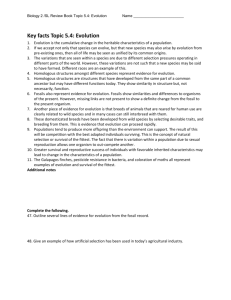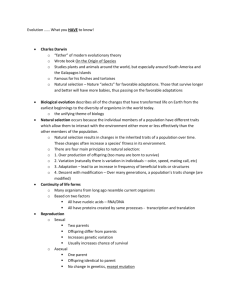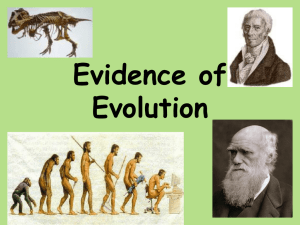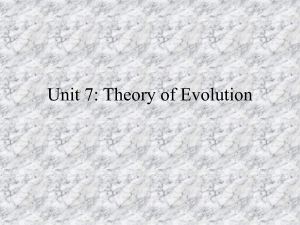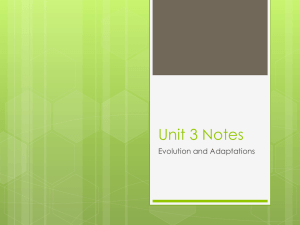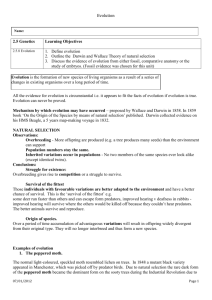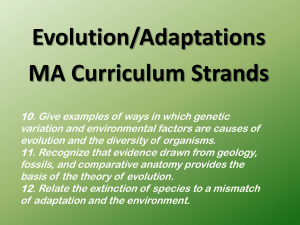Ch 15 Fossil Records
advertisement
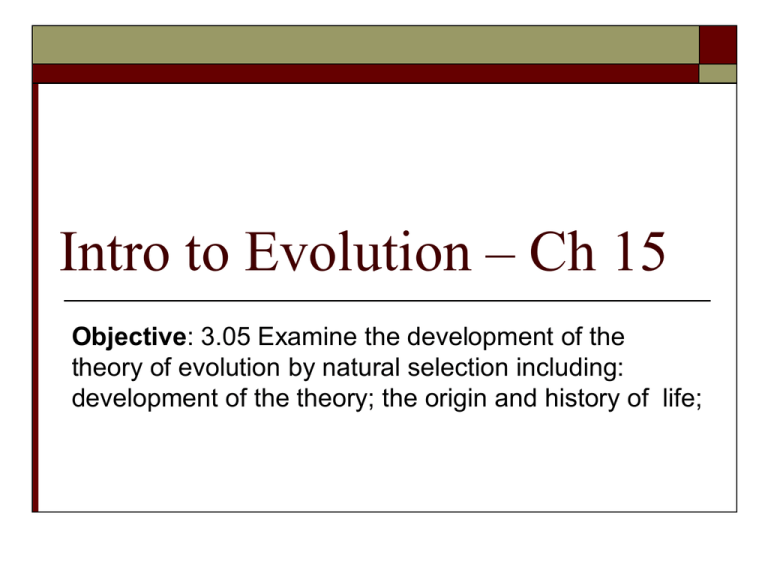
Intro to Evolution – Ch 15 Objective: 3.05 Examine the development of the theory of evolution by natural selection including: development of the theory; the origin and history of life; The Fossil Record Chapter 15.1 Objective: Examine the development of the theory of evolution by natural selection including: fossil and biochemical evidence; mechanisms of evolution; applications (pesticide and antibiotic resistance) Why use fossils? Scientists have used the fossil record to construct a history of life on Earth. Earth’s life forms appeared 3.5 billion years ago Fossil record is not complete, but pretty good for general information Fossils Trace of long-dead organism Formed in sediment – dust, sand, mud – by wind or water Hard body parts frozen in time Minerals replace soft tissue > rocks Types of fossils Mold – imprint of organism Cast – imprint replaced with minerals – looks like a model Evidence of behavior – footprints/tracks Insects petrified and frozen in amber Dating Fossils Relative Dating Rock layers are put down in order Oldest on bottom, youngest layers on top Radiometric Dating Use Carbon-14 for ages 50,000 years or less Half-life is 5730 years Nicolaus Steno Law of superposition – successive layers of rock or soil were deposited on top of one another by wind or water Stratum (lowest layer) – or layer in cross section is the oldest, top layer is youngest Earth’s age ~ 4.6 billion years Relative age – age by comparison e.g. I am older than you by comparison yet you don’t know my exact age E.g. the cement in the foundation of the building is older than the roof by comparison yet I don’t know the exact age in years of the building Absolute age – age in years by radiometric dating (carbon -14) Succession of forms Extinct – disappeared from existence Mass extinctions – large numbers of species disappeared – drastic environmental change like volcanic activity, collisions with asteroids First organisms begin with prokaryotes in Precambrian era (540 mya) Biogeography – study of the geographical distribution of fossils Indicates that organisms arise in areas where similar body forms lived suggesting that they are the new-improved model! A modified version Theories of Evolution Chapter 15.2 Objective: 3.05 Examine the development of the theory of evolution by natural selection including: development of the theory; the origin and history of life; Processes of science vs. processes of faith Science: Observe Ask questions Propose hypotheses Conduct Investigation Alter hypotheses Faith: Religious faith is a belief; Faith is not altered to fit evidence I ask students to learn theory of evolution – they don’t have to “believe” in it just understand it. I will not teach creationism nor intelligent design – they are not science Evolutionary Timeline Jean Baptiste de LaMarck inheritance of acquired traits – characteristic passed to offspring; not determined by genes repeated use or disuse of body part during their lifetime was then passed down to offspring or inherited E.g. webbed feet of duck Related fossils to living organisms based on similar appearance 1st to say organisms change over time Use & Disuse Organisms Could Change The Size Or Shape Of Organs By Using Them Or Not Using Them Blacksmiths & Their Sons (muscular arms) Giraffe’s Necks Longer from stretching) Inheritance Of Acquired Traits Traits Acquired During Ones Lifetime Would Be Passed To Offspring Clipped ears of dogs could be passed to offspring! Charles Darwin & Alfred Wallace Independently propose that species were modified by natural selection – when organisms with traits well suited to the environment reproduce more successfully than other organisms Published Origin of the Species Sailed on HMS Beagle to Galapagos Islands, west of S. America What is the Theory of Evolution by Natural Selection? Populations would grow exponentially if there were unlimited resources Environmental factors limit reproductive capacity Organisms compete for resources There is variation within populations and those with useful adaptations survive The survivors reproduce and pass on their genes The new generation will have a greater frequency of the adaptive traits Over a long period of time, the differences are so great that the result could be a new species HMS Beagle voyage Naturalist Read Principles of Geology by Charles Lyell Uniformitarianism – geological cycles observed today are the same processes from long ago e.g. volcanoes erupt the same today as millions of years ago Darwin sailed on the Beagle for 5 years making observations as the ship’s naturalist. He studied: tortoises, finches & more Island species varied from mainland species AND from island-to-island species Each island had long or short neck tortoises Finches: Finches on the islands resembled mainland finch More types of finches appeared on the islands where the available food was different (seeds, nuts, berries, insects…) Finches had different types of beaks adapted to their type of food gathering Evolved from a common remote ancestor phylogenetic tree - shows evolutionary relationships Phylogenetic Tree or Ancestral Tree showing proposed evolution Darwin’s 2 theories: Descent with modification Newer organisms in fossil record are modified descendants of older species All species descended from original type of life Modification by natural selection Organisms with favorable traits have more offspring than others without them– adaptive advantage Can adapt to environment therefore more fit Survival of the Fittest Fitness Ability of an Individual To Survive & Reproduce Adaptation Inherited Characteristic That Increases an Organisms Chance for Survival Survival of the Fittest Adaptations Can Be: Physical Speed, Camouflage, Claws, Quills, etc. Behavioral Solitary, Herds, Packs, Activity, etc. Survival of the Fittest Fitness Is Central To The Process Of Evolution Individuals With Low Fitness Die Produce Few Offspring Survival of the Fittest AKA Natural Selection Survival of the Fittest Key Concept Over Time, Natural Selection Results In Changes In The Inherited Characteristics Of A Population. These Changes Increase A Species Fitness In Its Environment Descent With Modification Takes Place Over Long Periods of Time Natural Selection Can Be Observed As Changes In Body Structures Ecological Niches Habitats Descent With Modification Species Today Look Different From Their Ancestors Each Living Species Has Descended With Changes From Other Species Over Time Descent With Modification EVIDENCE for EVOLUTION Evidence from fossils. The Geographical Distribution of Living Species Homologous Structures of Living Organisms Similarities In Early Development Homologous Body Structures Structures That Have Different Mature Forms But Develop From The Same Embryonic Tissues Homologous Body Structures Scientists Noticed Animals With Backbones (Vertebrates) Had Similar Bone Structure May Differ In Form or Function Limb Bones Develop In Similar Patterns Arms, Wings, Legs, Flippers Homologous Body Structures Not All Serve Important Functions Vestigial Organs Appendix In Man Legs On Skinks Similarities In Early Development Embryonic Structures Of Different Species Show Significant Similarities Embryo – early stages of vertebrate development Similarities In Embryonic Development Evidence from genetics. All organisms share the same basic mechanism of heredity (DNA/RNA) E.g.: mtDNA evidence for human evolution A branching tree radiating from a common ancestor – phylogenetic tree We can conduct research on other species to understand our own genes. Similarities in DNA Sequence Evolution in action. Many bacterial pathogens (origin of feeling – what started the disease) have evolved resistance to antibiotics In the case of HIV, which causes AIDS, significant viral evolution occurs within the course of infection of a single patient Evolution of drug-resistance in HIV •Many agricultural pests have evolved resistance to chemicals that farmers have used for only a few decades. •Moreover, scientists can perform experiments to study evolution in real time using bacteria and fruit flies that reproduce quickly. Evolution of pesticide resistance in response to selection
